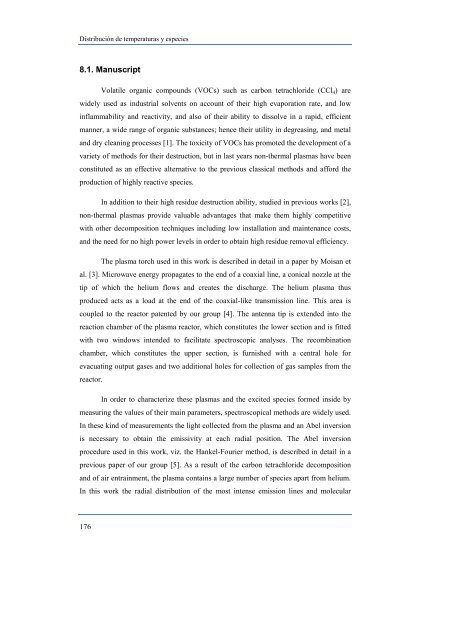estudio y caracterización de un plasma de microondas a presión ...
estudio y caracterización de un plasma de microondas a presión ...
estudio y caracterización de un plasma de microondas a presión ...
You also want an ePaper? Increase the reach of your titles
YUMPU automatically turns print PDFs into web optimized ePapers that Google loves.
Distribución <strong>de</strong> temperaturas y especies<br />
8.1. Manuscript<br />
176<br />
Volatile organic compo<strong>un</strong>ds (VOCs) such as carbon tetrachlori<strong>de</strong> (CCl4) are<br />
wi<strong>de</strong>ly used as industrial solvents on acco<strong>un</strong>t of their high evaporation rate, and low<br />
inflammability and reactivity, and also of their ability to dissolve in a rapid, efficient<br />
manner, a wi<strong>de</strong> range of organic substances; hence their utility in <strong>de</strong>greasing, and metal<br />
and dry cleaning processes [1]. The toxicity of VOCs has promoted the <strong>de</strong>velopment of a<br />
variety of methods for their <strong>de</strong>struction, but in last years non-thermal <strong>plasma</strong>s have been<br />
constituted as an effective alternative to the previous classical methods and afford the<br />
production of highly reactive species.<br />
In addition to their high residue <strong>de</strong>struction ability, studied in previous works [2],<br />
non-thermal <strong>plasma</strong>s provi<strong>de</strong> valuable advantages that make them highly competitive<br />
with other <strong>de</strong>composition techniques including low installation and maintenance costs,<br />
and the need for no high power levels in or<strong>de</strong>r to obtain high residue removal efficiency.<br />
The <strong>plasma</strong> torch used in this work is <strong>de</strong>scribed in <strong>de</strong>tail in a paper by Moisan et<br />
al. [3]. Microwave energy propagates to the end of a coaxial line, a conical nozzle at the<br />
tip of which the helium flows and creates the discharge. The helium <strong>plasma</strong> thus<br />
produced acts as a load at the end of the coaxial-like transmission line. This area is<br />
coupled to the reactor patented by our group [4]. The antenna tip is exten<strong>de</strong>d into the<br />
reaction chamber of the <strong>plasma</strong> reactor, which constitutes the lower section and is fitted<br />
with two windows inten<strong>de</strong>d to facilitate spectroscopic analyses. The recombination<br />
chamber, which constitutes the upper section, is furnished with a central hole for<br />
evacuating output gases and two additional holes for collection of gas samples from the<br />
reactor.<br />
In or<strong>de</strong>r to characterize these <strong>plasma</strong>s and the excited species formed insi<strong>de</strong> by<br />
measuring the values of their main parameters, spectroscopical methods are wi<strong>de</strong>ly used.<br />
In these kind of measurements the light collected from the <strong>plasma</strong> and an Abel inversion<br />
is necessary to obtain the emissivity at each radial position. The Abel inversion<br />
procedure used in this work, viz. the Hankel-Fourier method, is <strong>de</strong>scribed in <strong>de</strong>tail in a<br />
previous paper of our group [5]. As a result of the carbon tetrachlori<strong>de</strong> <strong>de</strong>composition<br />
and of air entrainment, the <strong>plasma</strong> contains a large number of species apart from helium.<br />
In this work the radial distribution of the most intense emission lines and molecular

















